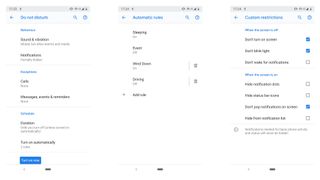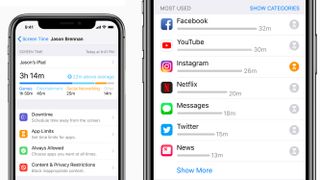Android Pie Digital Wellbeing Beta: a deep-dive into Google's new phone feature
Baby steps in the right direction, but still no parental controls
Reduce Interruptions

The final set of customization the Digital Wellbeing feature gives users is granular control over notification management and the Do Not Disturb setting.
Notification management offers options we’ve had in Android in the past, but it’s now located in the context of Digital Wellbeing - an arguably easier to access location than its old home within the apps settings.
Open it up and your screen is filled with all your apps in a vertical list, complete with toggles to the left to blanket turn on/off notifications for the corresponding app.
Everything gets much more comprehensive when you click through on one of your applications though, revealing an expanded notification control.
The level of notification management over Twitter, for example, one of the most overbearing applications when it comes notifications is as follows:
- Notifications can be turned on/off for individual accounts
- Within these accounts, notifications can be toggled for direct messages, emergency alerts, news, followers and contacts, security alerts and more
Not all application notifications are this extensively customizable yet, but serial offenders like Instagram, Facebook and Twitter are..
Better yet, this kind of granular constraint on which notifications vie for your attention doesn’t require a deep dive into the Digital Wellbeing menu.
Get daily insight, inspiration and deals in your inbox
Get the hottest deals available in your inbox plus news, reviews, opinion, analysis and more from the TechRadar team.
If Android Pie notices you swipe a type of notification out of the way repeatedly - for example “Chuck Norris is Live on Instagram” - it will ask you if you want to ignore that specific type of notification going forward. That isn’t to say Instagram notifications will be blocked, only Instagram live alerts.
Do not disturb

The final aspect of the Digital Wellness suite, Do not disturb, will likely the most familiar to most people. Click through and the sub-menu gives users control over what Do Not Disturb does - sound, vibration and notification alerts.
Here you can also set exceptions to the rule - calls and alarms for example, and you can schedule it on or off.
This scheduling can be fine tuned to set times, during a specific event, or it can even be automated to kick in when you’re driving, engaging with the phone’s location services to detect when you hit the road.
With all these features in tow, Android Pie looks set to be the best OS around for anyone concerned about smartphone addiction or general digital health, at least until iOS 12 drops.
As promising as all this is though, there’s no word from Google as to whether Digital Wellbeing will be made available for other manufacturers.
Verdict: it’s a start, but is it enough?
Without a doubt, Digital Wellbeing is a step in the right direction, and considering it’s only in Beta right now, it adds some meaningful support for Android users who want to be more conscious of their smartphone habits.
That said, the feature requires a degree of pro-activity to get any benefits from it. It’s also buried within the settings menu, with no option to add a shortcut to your home screen or access it a more convenient way.
If Digital Wellbeing comes pre-installed as part of Android in the future, tighter integration with the OS, easier access to it and some proactive hints, tips and tricks for maintaining a healthier relationship with technology could take it to the next level.
That said, there is one striking omission from the Digital Wellbeing dashboard: parental controls.
Studies on the negative effects smartphone use has specifically highlighted teens are most at risk of social media screen time negatively affecting their mental health.
Having a simple pin lock linked to the Dashboard so kids couldn’t override the time constraints so easily would have instantly made the feature a must have for parents.

What are other manufacturers doing?
Android’s only real competitor, iOS, is hot on Google’s heels with its upcoming iOS 12. Currently also in beta, its wellbeing center is called Screen Time and is also hidden within the settings.
Similar, but different to Digital Wellbeing on Android, it doesn’t cover notification control or offer monochrome/screen color options - found elsewhere in the settings.
Neither does it allow you to customize the Downtime, aka, do not disturb period, to the extent Android’s Wellbeing Dashboard does. Despite these differences though, it still manages to be win an important battle that could in turn, win the war - parental controls.
Screen Time’s parental control benefits boil down to one thing - passcode security. iOS, unlike Android supports a locked down system in which the amount of time within an app can only be restricted or unrestricted with a four digit pin.
This changes the game completely, turning a soft rule that can easily be moved into one that needs to be respected. With increased durations spent on social media linked to greater risk of depressive behavior in teens, limiting screen time with unbreakable rules could be the clincher. My advice to Google - get passcode security in there before Digital Wellbeing is out of Beta.
After all, apps are designed to be addictive - time spent using them is a major metric when app developers sell advertising - so app developers are unlikely to help users curb addictive behavior.
If any party is in the best position to support healthy smartphone use, it’s the OS maker. OS wellbeing features in Android will likely trickle down to the smartphone manufacturers, Samsung, OnePlus, Huawei for example, and then be built upon.
In short, the smartphone world is on a precipice - get behind Digital Wellbeing or play catch up. In 2019, the term will go from being a Beta user setting within Android to an important buzz phrase, but unlike buzz phrases of old, Digital Wellbeing is something we should all care about, if we don’t already.
- 1
- 2
Current page: Reduce interruptions, do not disturb and verdict
Prev Page What is it, why do we need it and how does it work?Basil Kronfli is the Head of content at Make Honey and freelance technology journalist. He is an experienced writer and producer and is skilled in video production, and runs the technology YouTube channel TechEdit.

